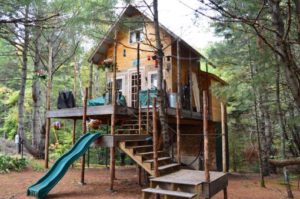Unique Homes Gaining Momentum as Buyers Gravitate Toward Sustainability
In a time where many of us are living paycheck to paycheck, Americans are downsizing their living space in an unorthodox way in an effort cut back expenses. Many buyers are flocking to the idea of unconventional housing like tiny homes, which have taken the real estate market by storm.
Typically, homes in the United States range from 2,000 to 2,500 sq. ft. in size. Tiny homes and other similar homes come in all shapes and sizes, but typically range from 100 to 400 sq. ft. There are many reasons society is moving toward this trend, from cutting costs to environmental concerns. Sometimes, it’s simply more convenient and the interest has grown quickly. Tiny/unconventional home websites have been popping up everywhere since the beginning of 2016.
United Country Real Estate agents across the country are finding themselves in unique situations – listing these types of sustainable and unique properties. Traci Gauthier of United Country – Lifestyle Properties of Maine in Bangor, Maine, currently has a tree house listed for sale. Described as a “tiny house,” the tree house is just 544 sq. ft. and sits on 23 acres. It offers one bedroom, a full bathroom and full-sized kitchen.


“The uniqueness of the tree house, besides it being a tiny house, is the fact that it’s ready to move in,” said Gauthier. “People love the décor and the land. Those who have seen it are very impressed with the use of space and how many comforts of home they are finding in such a small space.”
Interest in the tree house is booming. People from all over the country are skimming through pictures online and calling Gauthier with questions. A big reason, she said, is the fact that people are looking to live a more sustainable lifestyle and “make due with less.” Tiny homes like this can be heated with less than a tank of propane per season.
It’s all about sustainability and cost; something Mendy Reece of United Country – American Realty in Doniphan, Mo., is now dealing with almost daily. She just landed a very unique listing – a grain bin that has been converted into a one bedroom, one bath property that sits on 20 acres of recreational land. The owners originally converted the silo into a living space so they could avoid hauling around their RV.
“A lot of people around here are going green. Whether it’s organic gardening, converting to solar energy or living off the land in general,” said Reece. “Places like this make it a lot easier to do things like that. It could easily be converted to an off-the-grid property or would be perfect as a vacation or recreational property.”


One potential downfall of these tiny and unique properties? Reece says local appraisers in smaller towns like hers won’t touch it because it is so unique. That means searching for another appraiser or requiring the buyer to pay in cash. However, both Reece and Gauthier said that buyers looking to downsize to save on cost and live a sustainable lifestyle won’t change anytime soon.
“I expect the tiny and unique homes movement will just continue to grow in popularity,” said Gauthier. “There’s so many things you can do with it. You can even make it an investment. My sellers for the tree house are actually running a disc golf course and tree house rental in another part of the state and they have been swamped with inquires.”
The tiny house trend is still fresh, but it is continues to gain momentum. With endless possibilities and incoming producing opportunities, United Country agents foresee a continued interest sustainable and unique properties.
United Country Real Estate is the leading land seller in the United States, marketing ranches, farms, recreational and vacation properties nationally. It is the leading, fully integrated network of real estate professionals with nearly 500 offices and 4,000 agents, brokers and auctioneers nationwide specializing in lifestyle real estate.
United Country Real Estate has been named one of the top military friendly franchises by G.I. Jobs in their 2010 Military Friendly Franchise list, released this month.
Compiled through extensive research
United Country Real Estate is proud to announce today that Shawn Terrel, a 25-year veteran of the auction industry has been promoted to lead the United Country Real Estate |
Recent Posts
Archives
- May 2020
- April 2020
- March 2020
- February 2020
- November 2019
- September 2019
- August 2019
- April 2019
- March 2019
- January 2019
- November 2018
- October 2018
- September 2018
- August 2018
- April 2018
- January 2018
- September 2017
- August 2017
- June 2017
- April 2017
- March 2017
- January 2017
- December 2016
- November 2016
- October 2016
- September 2016
- July 2016
- June 2016
- May 2016
- April 2016
- March 2016
- December 2015
- November 2015
- October 2015
- September 2015
- August 2015
- July 2015
- January 2015
- December 2014
- August 2014
- July 2014
- June 2014
- February 2014
- December 2013
- November 2013
- October 2013
- August 2013
- January 2013
- June 2012
- May 2012
- April 2012
- March 2012
- January 2012
- May 2011
- April 2011
- February 2011
- December 2010
- November 2010
- October 2010
- September 2010
- August 2010
- July 2010
- June 2010
- May 2010
- April 2010
- March 2010
- February 2010
